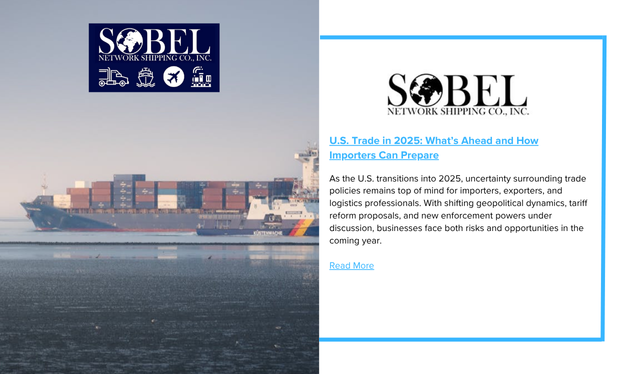As the U.S. transitions into 2025, uncertainty surrounding trade policies remains top of mind for importers, exporters, and logistics professionals. With shifting geopolitical dynamics, tariff reform proposals, and new enforcement powers under discussion, businesses face both risks and opportunities in the coming year.
Now that the 2024 presidential election has concluded, the incoming administration’s stance on trade is drawing scrutiny—particularly as tariffs continue to be a key agenda item. Importers are closely watching for policy announcements that may impact compliance, cost structures, and sourcing strategies. Here’s a look at the trade frameworks in play and how companies can prepare.
Section 301 and Section 232 Tariffs
Framework Overview:
-
Section 301 of the Trade Act of 1974 enables the U.S. to impose tariffs on countries engaging in unfair trade practices.
-
Section 232 of the Trade Expansion Act of 1962 allows for tariffs if imports threaten national security.
Historical Use:
-
Section 301 tariffs were used in 2018 to target a broad range of Chinese goods.
-
Section 232 duties have previously been applied to imported steel and aluminum.
What’s Possible in 2025:
President-Elect Trump has proposed an additional 10% tariff on all Chinese imports. If enacted under the standing Section 301 framework, this could be implemented rapidly via a USTR notice in the Federal Register, with or without tariff exclusions.
How to Prepare:
-
Track potential tariffs via the Federal Register.
-
Identify at-risk goods within your supply chain.
-
Quantify potential cost increases and prepare exclusion requests if applicable.
IEEPA (International Emergency Economic Powers Act)
Framework Overview:
IEEPA grants the President authority to regulate commerce during a declared national emergency. No investigation is required for action.
Historical Reference:
In 2019, the Trump administration threatened tariffs on Mexico under IEEPA, although they were never enforced.
What’s Possible in 2025:
Announcements of 25% tariffs on all imports from Canada and Mexico (as floated in November 2024) could be implemented via IEEPA. If declared, actions would be announced through presidential proclamation.
How to Prepare:
-
Maintain a centralized database of import commodities by origin.
-
Run “what-if” cost simulations.
-
Monitor for CBP and Federal Register guidance.
USMCA Six-Year Review
Framework Overview:
The U.S.–Mexico–Canada Agreement (USMCA) requires a joint review in 2026, but preparations—including public consultations—are expected to begin in late 2025.
What’s Possible:
If the U.S. chooses not to renew the agreement, it could enter annual renegotiation cycles until its expiration in 2036. Provisions like steel content rules and updated rules of origin will continue phasing in through 2027.
How to Prepare:
-
Stay informed via USTR communications and the Federal Register.
-
Submit public comments when invited.
-
Understand how regulatory updates impact your product classifications and sourcing strategies.
Key Takeaways
-
Expect Volatility: New tariffs may be announced or implemented with little notice.
-
Track Announcements: Subscribe to the Federal Register and monitor USTR and CBP communications.
-
Map Your Exposure: Identify goods, suppliers, and countries of origin that may be impacted.
-
Model Cost Scenarios: Use your HS codes and current sourcing to run tariff impact analyses.
-
Engage in Comment Periods: Participate in USTR hearings and public consultations when available.
-
Explore Mitigation Options: Consider FTZ usage or supply chain restructuring to reduce risk.
2025 promises to be a pivotal year for U.S. trade. Businesses that prepare now—by staying informed and proactive—will be better positioned to navigate potential disruptions and capitalize on new opportunities in a shifting global trade environment.


